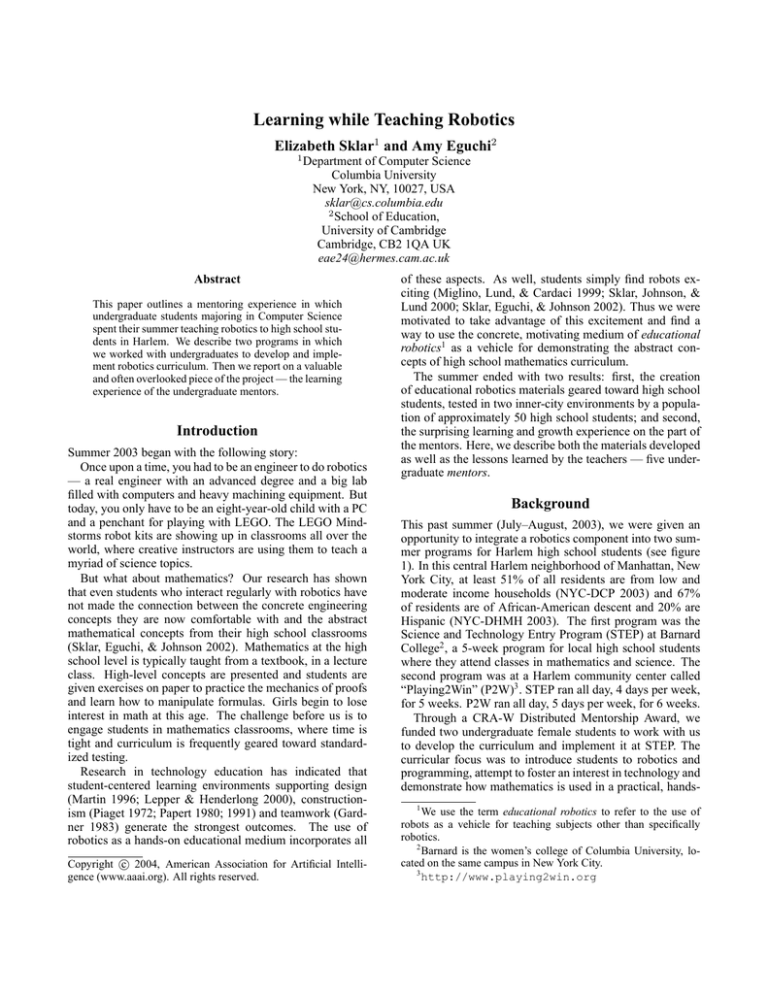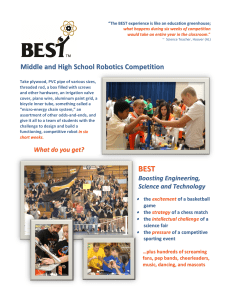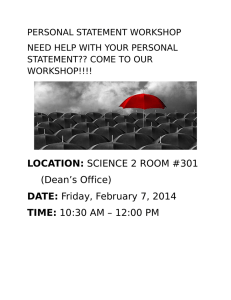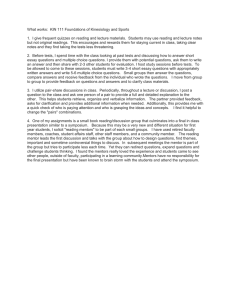
Learning while Teaching Robotics
Elizabeth Sklar1 and Amy Eguchi2
1
Department of Computer Science
Columbia University
New York, NY, 10027, USA
sklar@cs.columbia.edu
2
School of Education,
University of Cambridge
Cambridge, CB2 1QA UK
eae24@hermes.cam.ac.uk
Abstract
This paper outlines a mentoring experience in which
undergraduate students majoring in Computer Science
spent their summer teaching robotics to high school students in Harlem. We describe two programs in which
we worked with undergraduates to develop and implement robotics curriculum. Then we report on a valuable
and often overlooked piece of the project — the learning
experience of the undergraduate mentors.
Introduction
Summer 2003 began with the following story:
Once upon a time, you had to be an engineer to do robotics
— a real engineer with an advanced degree and a big lab
filled with computers and heavy machining equipment. But
today, you only have to be an eight-year-old child with a PC
and a penchant for playing with LEGO. The LEGO Mindstorms robot kits are showing up in classrooms all over the
world, where creative instructors are using them to teach a
myriad of science topics.
But what about mathematics? Our research has shown
that even students who interact regularly with robotics have
not made the connection between the concrete engineering
concepts they are now comfortable with and the abstract
mathematical concepts from their high school classrooms
(Sklar, Eguchi, & Johnson 2002). Mathematics at the high
school level is typically taught from a textbook, in a lecture
class. High-level concepts are presented and students are
given exercises on paper to practice the mechanics of proofs
and learn how to manipulate formulas. Girls begin to lose
interest in math at this age. The challenge before us is to
engage students in mathematics classrooms, where time is
tight and curriculum is frequently geared toward standardized testing.
Research in technology education has indicated that
student-centered learning environments supporting design
(Martin 1996; Lepper & Henderlong 2000), constructionism (Piaget 1972; Papert 1980; 1991) and teamwork (Gardner 1983) generate the strongest outcomes. The use of
robotics as a hands-on educational medium incorporates all
c 2004, American Association for Artificial IntelliCopyright °
gence (www.aaai.org). All rights reserved.
of these aspects. As well, students simply find robots exciting (Miglino, Lund, & Cardaci 1999; Sklar, Johnson, &
Lund 2000; Sklar, Eguchi, & Johnson 2002). Thus we were
motivated to take advantage of this excitement and find a
way to use the concrete, motivating medium of educational
robotics1 as a vehicle for demonstrating the abstract concepts of high school mathematics curriculum.
The summer ended with two results: first, the creation
of educational robotics materials geared toward high school
students, tested in two inner-city environments by a population of approximately 50 high school students; and second,
the surprising learning and growth experience on the part of
the mentors. Here, we describe both the materials developed
as well as the lessons learned by the teachers — five undergraduate mentors.
Background
This past summer (July–August, 2003), we were given an
opportunity to integrate a robotics component into two summer programs for Harlem high school students (see figure
1). In this central Harlem neighborhood of Manhattan, New
York City, at least 51% of all residents are from low and
moderate income households (NYC-DCP 2003) and 67%
of residents are of African-American descent and 20% are
Hispanic (NYC-DHMH 2003). The first program was the
Science and Technology Entry Program (STEP) at Barnard
College2 , a 5-week program for local high school students
where they attend classes in mathematics and science. The
second program was at a Harlem community center called
“Playing2Win” (P2W)3 . STEP ran all day, 4 days per week,
for 5 weeks. P2W ran all day, 5 days per week, for 6 weeks.
Through a CRA-W Distributed Mentorship Award, we
funded two undergraduate female students to work with us
to develop the curriculum and implement it at STEP. The
curricular focus was to introduce students to robotics and
programming, attempt to foster an interest in technology and
demonstrate how mathematics is used in a practical, hands1
We use the term educational robotics to refer to the use of
robots as a vehicle for teaching subjects other than specifically
robotics.
2
Barnard is the women’s college of Columbia University, located on the same campus in New York City.
3
http://www.playing2win.org
Curriculum
The curriculum developed for the summer programs is centered around LEGO Mindstorms robotic kits (see figure 2)
and the RoboLab graphic programming environment (see
figure 3). The assumption is that the students have no prior
experience programming or building robots.
Figure 2: LEGO Mindtsorms Robot kit.
A sequence of seven basic lessons in robotics were created:
Figure 1: Participants in the summer programs.
• Basic Construction
• Basic Programming
• Touch Sensor
on setting — while still having fun. Playing2Win funded
three additional undergraduates (two males and one female)
to implement the same curriculum.
Overall, approximately 50 high school students participated in this project. We conducted a pilot study, examining the learning experiences of the high school students, in
an attempt to see how their interest in technology changed
during the course of the summer and if any improvement in
their problem solving skills was evident. This type of study
is frequently conducted, focusing on the students who are
the subjects of the new curriculum.
However, as the summer unfolded, we began to realize
that we were overlooking a tremendous learning opportunity by studying the mentors, the undergraduates who were
developing and delivering the curriculum. What follows is
our evaluation and assessment of the undergraduates’ experiences, obtained through observation and interviews with
these mentors at the end of the summer. Note that for the
remainder of this article, we use the term “mentors” to refer
to the undergraduates and the term “students” to refer to the
high school students who attended the summer programs.
We begin by outlining the curriculum developed, to illustrate the types of lessons the mentors were implementing. Since the focus of this paper is on the mentors’ experiences, rather than the curriculum developed, this description
is brief. Complete details of the lessons can be found on the
web site referenced at the end of the paper.
• If Structures
• Loop Structures
• Light Sensors
• Advanced Programming
Figure 3: RoboLab programming environment.
In the first two lessons (Basic Construction and Basic Programming), students were given a model robot and sample
programs to copy. We found that giving them a physical
model to emulate was more educational than providing the
students with step-by-step building plans to follow. Similarly, the students seemed to have an easier time learning
how to program by starting with working code, testing its
limitations, modifying it and testing again.
Then, with each subsequent lesson, the students were
given a challenge — a task to perform given the new material they were presented with that day. For example, with
the Light Sensor lesson, students were given the following
specification: “If the robot begins on a black area, then move
forward; but if the robot begins in a white area, then go backwards. The robot shouldn’t go forwards or backwards forever.” With each lesson, at least one of the challenges included the use of sound. The RoboLab programming environment has a nice and simple interface for writing “music”
for the robots. We observed that this aspect seemed to be
particularly engaging for the female students.
Following the Advanced Programming lesson, specific
lessons that demonstrate high school math and physics concepts using the robots were developed. For example:
• Discrete vs Continuous Systems
• Geometry
• Circumference
• Algebra
These lessons let students explore the scope of the physical
robots while experimenting with basic principles.
Experience
The bulk of the robotics curriculum was developed by two
female undergraduate students majoring in Computer Science. Both entered their third year in college in the subsequent fall term (i.e., after the summer experience was
over). These two students implemented the material at
STEP. Three other undergraduates — two male and one female — all entering their fourth year in college and all majoring in Computer Science — delivered the same material
at Playing2Win. Four of the undergraduates are students at
Columbia University; the fifth is a student at Oregon State
University.
There were about 12 students in each of two classes in
STEP. At Playing2Win, there were approximately 20 students in each of two classes. In both programs, adult teaching staff was present to help the undergraduates by providing
extra pairs of hands and to intervene if and when discipline
problems might occur. The students in both programs were
self-selected — i.e., participation was voluntary, though any
parental pressure exerted on the students to attend is an unknown factor. Both programs were co-ed, and most students
were in the first two years of high school, ranging in age
from 14 to 16 years. The vast majority of participants in
both groups were minorities, more than 50% were female
— altogether, the participants were mostly from groups typically disenfranchised from engineering subjects.
The two STEP classes met four days per week, for 90
minutes in each session. The two Playing2Win classes met
twice per week, for 2 hours per session.
At the conclusion of the summer, we interviewed all of the
undergraduates about their experiences, focusing on their
teaching interests and abilities and on their personal impressions of the project.
Two of the undergraduate mentors stated that they had
had previous teaching experience working with students of
their own age; however, none of them had experience teaching younger students. None of the undergraduate mentors
received any pedagogical instruction prior to the program.
Statements from all of them indicated that they learned
various pedagogical strategies through their summer workshop experience. The pedagogical strategies they learned
included strategies of building rapport and sound relationships with students, balancing their authority with close and
friendly relationships with students, helping students to become engaged in their activities and providing useful support to enhance the students’ learning.
Because of the characteristic of these summer programs,
the attendance of the students was not constant (i.e., absenteeism was an issue). The undergraduates had difficulty
dealing with the diverse levels of students’ knowledge and
skills coming into the program, exacerbated by the attendance problem, and they found this to be frustrating. However, they came up with their own strategies to deal with the
situation and keep the activities going. For example, they
decided to place in one group all the students who were not
grasping certain concepts.
They quickly discovered that the ratio of mentors to students was crucial. If there were too many students per mentor, then the students became unruly and the lesson fell apart.
But if there were too few students per mentor, then the students used the mentor as a crutch and did not learn to do
things for themselves.
One of the most important lessons learned by the mentors
was “flexibility.” There were significant cultural differences
between the mentors and the Harlem students, particularly
for the mentors who did not grow up in an urban environment. In the beginning, it was challenging for the mentors to
understand the students: how they reacted and why they reacted in various ways. But, gradually toward the end of the
program, the mentors learned how to be flexible and meet
the needs of the variety of students they were facing.
For all five undergraduates, the experience was positive.
They gained confidence in themselves, their teaching abilities and their presentation skills. They also learned about
themselves and enjoyed teaching, as one of the male mentors
remarked: “I learned a lot about teaching, patience, classroom dynamics. It’s all really interesting. I learned that I
get really hyper when teaching a lecture, but it’s fun. I like
to break formality and let the students feel personally connected to the material, let them take charge and gain confidence — that’s the ideal of course.” He continued by responding to the question, “Did you regret that you did it?”:
“I’m quite glad I did it — I hope that the students all go on
to do really cool things.”
The experience of encountering problems related to the
technology and materials that they were conveying became
a motivating factor for the undergraduates to master the technology and materials themselves. Most of the mentors had
difficulty solving problems they encountered at first, because they were not familiar enough with the lesson plans,
the technologies and/or the materials beforehand. They all
agreed that they need to learn all the educational robotics
components very well — well enough to troubleshoot problems they encounter while teaching, while under time pressure and pressure from students watching them impatiently
and harassing them if they cannot fix problems right away.
Moreover, the difficulties that the mentors faced during the
first stages of the program motivated two of the female stu-
dents to develop educational robotics lesson plans, teaching
materials and a workbook with useful resources including
the possible problems and troubleshooting tips. These are
available from:
http://agents.cs.columbia.edu/er/curriculum
Summary
In summary, we have briefly described two summer programs in which undergraduate Computer Science students
acted as mentors for inner-city high school students. We
have outlined robotics materials developed and implemented
by these mentors. We observed through the summer growth
not only in terms of educational robotics materials but also
in terms of the social, pedagogical and communication skills
of the undergraduate mentors involved in the program. This
led us to begin to examine the mentoring experience from
the standpoint of the undergraduates. We include a preliminary report here, which showed that all of the undergraduate students involved gained confidence through the program, improved their teaching and communication skills,
and also improved their technical skills and knowledge
through teaching.
Acknowledgments.
We gratefully acknowledge the participation of the five undergraduate students who were involved in this program:
Rachel Goldman, Kami Vaniea, Phoebe Ford, Michael
Weiss and Jacob Porway; as well as graduate student Joshua
Reich who helped develop the math and physics curriculum. We also acknowledge the leaders at each of the summer programs, STEP and Playing2Win. This effort was
funded in part by a CRA-W Distributed Mentorship Award
and by NSF #DGE-00-86390 “GK12: Integrating New Media Technologies into Teacher Development”.
References
Gardner, H. 1983. Frames of Mind: The Theory of Multiple
Intelligences. BasicBooks.
Lepper, M., and Henderlong, J. 2000. Turning “play” into
“work” and “work” into “play”: 25 years of research on
intrinsic versus extrinsic motivation. Academic Press.
Martin, F. 1996. Ideal and Real Systems — A Study of Notions of Control in Undergraduates Who Design Robots.
Constructionism in Practice: Designing, Thinking, and
Learning in a Digital World.
Miglino, O.; Lund, H.; and Cardaci, M. 1999. Robotics
as an Educational Tool. Journal of Interactive Learning
Research 10(1).
NYC-DCP. 2003. 2000 Census Tract Community Development Block Grant Eligibility Maps. Technical report,
New York City Department of City Planning.
NYC-DHMH. 2003. New York City Neighborhood Health
Profiles: Manhattan, 2000. Technical report, New York
City Department of Health and Mental Hygiene.
Papert, S. 1980. Mindstorms: Children, Computers, and
Powerful Ideas. BasicBooks.
Papert, S. 1991. Situating Constructionism. Constructionism.
Piaget, J. 1972. To Understand Is To Invent. New York:
The Viking Press, Inc.
Sklar, E.; Eguchi, A.; and Johnson, J. 2002. RoboCupJunior: learning with educational robotics. In Proceedings of
RoboCup-2002: Robot Soccer World Cup VI.
Sklar, E.; Johnson, J.; and Lund, H. 2000. Children Learning from Team Robotics: RoboCup Junior 2000 Educational Research Report. Technical report, The Open University, Milton Keynes, UK.




